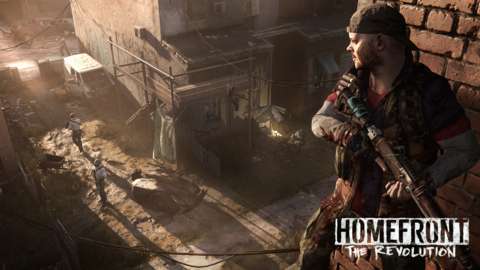E3 2014: Can Homefront: The Revolution's Story Do Justice to Its Pretty Visuals?
Far out Philly.
I was as confused as anyone when Crytek picked up the Homefront licence from a crumbling THQ back in 2012. After all, why would anyone want the licence to a game that didn't review particularly well, and partly contributed to the downfall of its publisher? It's hardly like there's much goodwill attached to the name. Yet, here we are at E3 2014, where Crytek has finally taken the wraps off its take on the Homefront series--and what a familiar take it is.
Senua's Saga: Hellblade II Everything To Know The Rogue Prince of Persia - Official New Release Date Gameplay Trailer Genshin Impact - Cutscene Animation "Arataki & Flying Lavender Melon's Rockin' for Life Duet" MultiVersus – Official The Joker Gameplay Reveal Trailer | “Send in the Clowns!” 15 MORE Things You STILL Didn't Know In Zelda Tears Of The Kingdom Firearms Expert Reacts to Ghost Recon Breakpoint's Guns Xbox Studio Closures Are Confusing | Spot On Gray Zone Warfare | Community Briefing Trailer #1 Squirrel With A Gun - Official Announcement Gameplay Trailer Night Slashers: Remake || Official Christopher Smith Character Gameplay Trailer Senua's Saga: Hellblade II - Senua's Psychosis Feature Trailer Street Fighter 6 - 8 Minutes of Akuma Gameplay (High-Level CPU)
Please enter your date of birth to view this video
By clicking 'enter', you agree to GameSpot's
Terms of Use and Privacy Policy
Crytek hasn't strayed too far from the themes of the original Homefront. Set in 2029, two years after the events of Homefront, the story revolves around the continued occupation of the United States by the Greater Korean Republic. The western states have been freed from its control, but over in the east, it's very much the leading power. Cue a move to a dystopian version of Philadelphia, a city in the iron grip of the KPA. The citizens are living under military control, with constant surveillance being carried out by armed guards and cameras scattered around the city.
An oppressed, dystopian version of a real-world city isn't the most challenging of settings, but it has meant Crytek is doing something very different to what it does with its Crysis series. In Crysis, you're very much the all-powerful muscle-bound guy on a one-man crusade to save the world (or four-man if you play in four-player co-op). In Homefront, you play as Ethan Grady, a regular guy who's simply trying to kick-start the uprising that will lead to revolution. You have no special skills, other than you're not too bad with a gun and at scrounging useful tools from abandoned buildings.

That act of scavenging and dealing in guerrilla tactics is very much the focus of Homefront: The Revolution, or at least that's how Crytek is selling it. You can smash security cameras and make makeshift remote bombs from an RC Car (as seen in our stage demo above). Then there are your weapons, which can be tweaked on the fly using bits and pieces you've found. How the game's focus on guerrilla tactics holds up remains to be seen, particularly as the demo quickly moves into run-and-gun action after its sneakier moments.
My biggest worry, though, is that Crytek hasn't had a particularly good track record when it comes to narratives, or at least, I haven't found the likes of Crysis 3 and Ryse: Son of Rome all that appealing. Homefront: The Revolution's story might not be the most original out there, but it's being deeply integrated into the game, meaning it's got to hold up if players aren't going to lose interest.
Crytek's strengths have always been in visual design, and there's no denying that Homefront: The Revolution is a very pretty game. Naturally, it's running on the latest version of Cryengine, and the crumbling city of Philadelphia looks stunning. Being set at night certainly helps with that. The darkened alleyways of the city, dimly lit by street lamps, and the flickers of light peeking through a window from a nearby drone have been expertly done. The game is only being made for more modern systems (Xbox One, PlayStation 4, PC, Mac, and yes, even Linux), and it definitely shows in how gorgeous it looks. I just hope there are brains behind the beauty.
See more coverage of E3 2014 →
Got a news tip or want to contact us directly? Email news@gamespot.com
Join the conversation